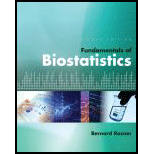
Fundamentals of Biostatistics
8th Edition
ISBN: 9781305268920
Author: Bernard Rosner
Publisher: Cengage Learning
expand_more
expand_more
format_list_bulleted
Concept explainers
Textbook Question
Chapter 2, Problem 46P
Answer Problems 2.38–2.40 for BMD for the femoral shaft.
2.40 What impression do you have of the relationship between BMD and tobacco use based on Problem 2.39?
Expert Solution & Answer
Want to see the full answer?
Check out a sample textbook solution
Students have asked these similar questions
During busy political seasons, many opinion polls are conducted. In apresidential race, how do you think the participants in polls are generally selected?Discuss any issues regarding simple random, stratified, systematic, cluster, andconvenience sampling in these polls. What about other types of polls, besides political?
Please could you explain why 0.5 was added to each upper limpit of the intervals.Thanks
28. (a) Under what conditions do we say that two random variables X and Y are
independent?
(b) Demonstrate that if X and Y are independent, then it follows that E(XY) =
E(X)E(Y);
(e) Show by a counter example that the converse of (ii) is not necessarily true.
Chapter 2 Solutions
Fundamentals of Biostatistics
Ch. 2.6 - When is it appropriate to use the arithmetic mean...Ch. 2.6 - How does the geometric mean differ from the...Ch. 2.6 - What is the difference between the standard...Ch. 2.8 - What is a stem-and-leaf plot? How does it differ...Ch. 2.8 - Prob. B.2RECh. 2.8 - Consider the stem-and-leaf plot in Figure 2.6. Is...Ch. 2.8 - What is a box plot? What additional information...Ch. 2 - The data in Table 2.13 are a sample from a larger...Ch. 2 - The data in Table 2.13 are a sample from a larger...Ch. 2 - It is of clinical interest to know if the duration...
Ch. 2 - Suppose the scale for a data set is changed by...Ch. 2 - Suppose the scale for a data set is changed by...Ch. 2 - Suppose the scale for a data set is changed by...Ch. 2 - Suppose the scale for a data set is changed by...Ch. 2 - A man runs 1 mile approximately once per weekend....Ch. 2 - A man runs 1 mile approximately once per weekend....Ch. 2 - A man runs 1 mile approximately once per weekend....Ch. 2 - A man runs 1 mile approximately once per weekend....Ch. 2 - A man runs 1 mile approximately once per weekend....Ch. 2 - The data in Table 2.15 are a sample of cholesterol...Ch. 2 - The data in Table 2.15 are a sample of cholesterol...Ch. 2 - The data in Table 2.15 are a sample of cholesterol...Ch. 2 - The data in Table 2.15 are a sample of cholesterol...Ch. 2 - The data in Table 2.15 are a sample of cholesterol...Ch. 2 - In an experiment that examined the effect of body...Ch. 2 - In an experiment that examined the effect of body...Ch. 2 - Table 2.17 Format for FEV.DAT The data in Table...Ch. 2 - Forced expiratory volume (FEV) is an index of...Ch. 2 - Forced expiratory volume (FEV) is an index of...Ch. 2 - Prob. 26PCh. 2 - The food-frequency questionnaire (FFQ) is an...Ch. 2 - In Section 2.9, we described Data Set LEAD.DAT (at...Ch. 2 - In Section 2.9, we described Data Set LEAD.DAT (at...Ch. 2 - Activated-protein-C (APC) resistance is a serum...Ch. 2 - Activated-protein-C (APC) resistance is a serum...Ch. 2 - A study was conducted to demonstrate that soy...Ch. 2 - A study was conducted to demonstrate that soy...Ch. 2 - A study was conducted to demonstrate that soy...Ch. 2 - Prob. 38PCh. 2 - In Section 2.10, we described Data Set BONEDEN.DAT...Ch. 2 - What impression do you have of the relationship...Ch. 2 - In Section 2.10, we described Data Set BONEDEN.DAT...Ch. 2 - In Section 2.10, we described Data Set BONEDEN.DAT...Ch. 2 - Prob. 43PCh. 2 - Prob. 44PCh. 2 - Prob. 45PCh. 2 - Answer Problems 2.382.40 for BMD for the femoral...Ch. 2 - The Left Ventricular Mass lndex (LVMI) is a...Ch. 2 - Prob. 48PCh. 2 - Prob. 49PCh. 2 - The Left Ventricular Mass lndex (LVMI) is a...
Knowledge Booster
Learn more about
Need a deep-dive on the concept behind this application? Look no further. Learn more about this topic, statistics and related others by exploring similar questions and additional content below.Similar questions
- 19. Let X be a non-negative random variable. Show that lim nE (IX >n)) = 0. E lim (x)-0. = >arrow_forward(c) Utilize Fubini's Theorem to demonstrate that E(X)= = (1- F(x))dx.arrow_forward(c) Describe the positive and negative parts of a random variable. How is the integral defined for a general random variable using these components?arrow_forward
- 26. (a) Provide an example where X, X but E(X,) does not converge to E(X).arrow_forward(b) Demonstrate that if X and Y are independent, then it follows that E(XY) E(X)E(Y);arrow_forward(d) Under what conditions do we say that a random variable X is integrable, specifically when (i) X is a non-negative random variable and (ii) when X is a general random variable?arrow_forward
arrow_back_ios
SEE MORE QUESTIONS
arrow_forward_ios
Recommended textbooks for you
 Functions and Change: A Modeling Approach to Coll...AlgebraISBN:9781337111348Author:Bruce Crauder, Benny Evans, Alan NoellPublisher:Cengage Learning
Functions and Change: A Modeling Approach to Coll...AlgebraISBN:9781337111348Author:Bruce Crauder, Benny Evans, Alan NoellPublisher:Cengage Learning

Functions and Change: A Modeling Approach to Coll...
Algebra
ISBN:9781337111348
Author:Bruce Crauder, Benny Evans, Alan Noell
Publisher:Cengage Learning
Which is the best chart: Selecting among 14 types of charts Part II; Author: 365 Data Science;https://www.youtube.com/watch?v=qGaIB-bRn-A;License: Standard YouTube License, CC-BY